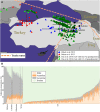The Origins of Ashkenaz, Ashkenazic Jews, and Yiddish
- PMID: 28680441
- PMCID: PMC5478715
- DOI: 10.3389/fgene.2017.00087
The Origins of Ashkenaz, Ashkenazic Jews, and Yiddish
Abstract
Recently, the geographical origins of Ashkenazic Jews (AJs) and their native language Yiddish were investigated by applying the Geographic Population Structure (GPS) to a cohort of exclusively Yiddish-speaking and multilingual AJs. GPS localized most AJs along major ancient trade routes in northeastern Turkey adjacent to primeval villages with names that resemble the word "Ashkenaz." These findings were compatible with the hypothesis of an Irano-Turko-Slavic origin for AJs and a Slavic origin for Yiddish and at odds with the Rhineland hypothesis advocating a Levantine origin for AJs and German origins for Yiddish. We discuss how these findings advance three ongoing debates concerning (1) the historical meaning of the term "Ashkenaz;" (2) the genetic structure of AJs and their geographical origins as inferred from multiple studies employing both modern and ancient DNA and original ancient DNA analyses; and (3) the development of Yiddish. We provide additional validation to the non-Levantine origin of AJs using ancient DNA from the Near East and the Levant. Due to the rising popularity of geo-localization tools to address questions of origin, we briefly discuss the advantages and limitations of popular tools with focus on the GPS approach. Our results reinforce the non-Levantine origins of AJs.
Keywords: Archaeogenetics; Ashkenaz; Ashkenazic Jews; Rhineland hypothesis; Yiddish; ancient DNA; geographic population structure (GPS).
Figures

Similar articles
-
Localizing Ashkenazic Jews to Primeval Villages in the Ancient Iranian Lands of Ashkenaz.Genome Biol Evol. 2016 Apr 19;8(4):1132-49. doi: 10.1093/gbe/evw046. Genome Biol Evol. 2016. PMID: 26941229 Free PMC article.
-
Yiddish Language and Ashkenazic Jews: A Perspective from Culture, Language, and Literature.Genome Biol Evol. 2016 Jul 2;8(6):1948-9. doi: 10.1093/gbe/evw131. Genome Biol Evol. 2016. PMID: 27289098 Free PMC article. Review.
-
Pitfalls of the Geographic Population Structure (GPS) Approach Applied to Human Genetic History: A Case Study of Ashkenazi Jews.Genome Biol Evol. 2016 Aug 16;8(7):2259-65. doi: 10.1093/gbe/evw162. Genome Biol Evol. 2016. PMID: 27389685 Free PMC article. Review.
-
Origin and spread of the 1278insTATC mutation causing Tay-Sachs disease in Ashkenazi Jews: genetic drift as a robust and parsimonious hypothesis.Hum Genet. 2004 Mar;114(4):366-76. doi: 10.1007/s00439-003-1072-8. Epub 2004 Jan 15. Hum Genet. 2004. PMID: 14727180
-
Speech disfluencies in bilingual Yiddish-Dutch speaking children.Clin Linguist Phon. 2020 Jun 2;34(6):576-592. doi: 10.1080/02699206.2019.1678670. Epub 2019 Oct 23. Clin Linguist Phon. 2020. PMID: 31645140
Cited by
-
The Diversity of REcent and Ancient huMan (DREAM): A New Microarray for Genetic Anthropology and Genealogy, Forensics, and Personalized Medicine.Genome Biol Evol. 2017 Dec 1;9(12):3225-3237. doi: 10.1093/gbe/evx237. Genome Biol Evol. 2017. PMID: 29165562 Free PMC article.
-
Pair Matcher (PaM): fast model-based optimization of treatment/case-control matches.Bioinformatics. 2019 Jul 1;35(13):2243-2250. doi: 10.1093/bioinformatics/bty946. Bioinformatics. 2019. PMID: 30445488 Free PMC article.
-
Clinical, laboratory and molecular features of glycogen storage disease type 1a and 1b patients from Turkey: novel mutations and phenotypes.Eur J Pediatr. 2025 Aug 9;184(9):540. doi: 10.1007/s00431-025-06371-7. Eur J Pediatr. 2025. PMID: 40781175
-
Application of geographic population structure (GPS) algorithm for biogeographical analyses of populations with complex ancestries: a case study of South Asians from 1000 genomes project.BMC Genet. 2017 Dec 28;18(Suppl 1):109. doi: 10.1186/s12863-017-0579-2. BMC Genet. 2017. PMID: 29297311 Free PMC article.
-
The story of the lost twins: decoding the genetic identities of the Kumhar and Kurcha populations from the Indian subcontinent.BMC Genet. 2020 Oct 22;21(Suppl 1):117. doi: 10.1186/s12863-020-00919-2. BMC Genet. 2020. PMID: 33092524 Free PMC article.
References
-
- Atzmon G., Hao L., Pe'er I., Velez C., Pearlman A., Palamara P. F., et al. . (2010). Abraham's children in the genome era: major Jewish diaspora populations comprise distinct genetic clusters with shared Middle Eastern ancestry. Am. J. Hum. Genet. 86, 850–859. 10.1016/j.ajhg.2010.04.015 - DOI - PMC - PubMed
-
- Baron S. W. (1937). Social and Religious History of the Jews, vol. 1 New York, NY: Columbia University Press.
-
- Baron S. W. (1952). Social and Religious History of the Jews, vol. 2 New York, NY: Columbia University Press.
Grants and funding
LinkOut - more resources
Full Text Sources
Other Literature Sources

